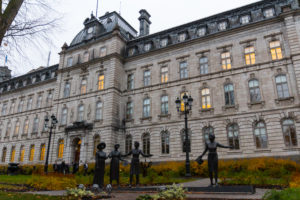
For most foreign observers, Canada is a fascinating and gifted country. Its citizens enjoy a high standard of living. With rapid population increase since the war, there has been substantial economic growth. The country is fabulously endowed with natural resources, including enough energy resources to be virtually self-sufficient. This, coupled with the high educational level of population, suggests that Canada could sustain high growth rates.
Nevertheless, the general mood is decisively pessimistic. In the early 1950’s, Canadians were proud of their country and confident that it could play a major role in world affairs. Today, even though they have many reasons to be pleased with what has been accomplished and look toward the future with confidence, Canadians are indulging in a never-ending search for their identity. In particular, the Canadian elite appears to be stuck with an adolescent search for self. As of late, if one is to judge from the number of conferences held across the country, it appears to be having group psychotherapy on Canadian identity. Normally, people don’t anguish over who they are; they just know. This suggests to me that the search itself, the anguish itself, is what Canadians are looking for.
“Regions,” “regional,” and “regionalism” are three of the most common terms in Canadian political discourse. Yet the meanings of these terms are confused. The territorial basis of a region and thus its relevance to real community feelings and identity depends on whom you are speaking to. As a general rule, the less one knows about Canada, the larger are the regions. For instance, New Brunswick, Prince Edward Island, Nova Scotia and Newfoundland are often lumped together in what is termed the Atlantic Provinces, though anyone who has visited these provinces knows that they constitute quite different communities. As a matter of fact, we are witnessing within each province the emergence of “regional” entities with a definite commitment to growth. Good examples of this are the Miramichi area and the “republic of Madawaska,” not to mention the Acadian Peninsula, all of which are in New Brunswick.
I share the opinion of Richard Simeon to the effect that the regionalized character of Canadian politics is not only a function of the territorial character of our underlying ethnic, economic and cultural diversity, but also, and perhaps more important, a result of the operation of three major institutional characteristics of Canadian government: the federal system, the electoral system and the British style of government by cabinet.
This framework helps explain the nature of the constitutional conundrum. There are two closely woven threads in the stances taken with respect to constitutional matters.
There is, on the one hand, the sensitivity of people who feel that Canada has not kept the promises of Confederation. This is a major grievance of French Canadians who share the view that their national identity has been trampled upon in a succession of humiliating actions.
There is, on the other hand, the very real and often acrimonious debate between the provincial and federal governments over issues of jurisdiction and autonomy. By design, a federation is an attempt to get the best of two worlds; the advantages of a unified state and the benefits of the diversity inherent in the regions and the peoples which form the state. These two elements create continuous pressures to change the balance of power between the federal and provincial governments.
In effect, Canada has oscillated between periods of centralization and decentralization, as is clearly illustrated by the following figures. In 1870, federal expenditures for goods and services represented 52 percent of the total of all such government expenditures in Canada; by 1920, this percentage amounted to only 26 percent. It rose back close to the old level — to 48 percent — 1950. Now it has decreased again, to 25 percent in 1975.
Shifts in power endemic to a federal system of government have led observers to apply to it the metaphor of a pendulum swinging back and forth between centralization and decentralization. On the one hand, the mere existence of a country governed centrally in some important policy fields sets forces in favour of centralization. On the other hand, the emergence of regional identities and allegiances stems from the fact that each provincial region is required to establish the necessary network of institutions to carry out the responsibilities that fall within its domain of jurisdiction.
That the pendulum has swung between centralization and decentralization through Canadian history does not imply that the process has operated smoothly. At times the pendulum has shown a tendency to get stuck in Ottawa. This tends to give rise to a destructive process. In order to obtain a fair balance, the provincial governments have had to build a cohesive political base by drumming up regionalist sentiments. The feeling within each region is similar: they have been (deprived) of what they rightly deserve at the expense of other regions of the country. Opinion polls confirm that, from the point of view of the provincial politicians, this strategy has been effective. The outcome has been to weaken the confidence of the Canadian people in their central government.
It is not a coincidence that the current Canadian constitutional problem began in the early 1960’s. Profound demographic changes were at work. The children of the baby boom were then reaching school age; as a result, the national priorities were shifting towards education and social matters, both of which, under our Constitution, are the responsibility of the provinces. But more importantly, this period was also marked by the emergence of what is commonly called the “new middle class.” With the growth and the increased size of large-scale formal organizations in business and government, the middle class was predominantly transformed into a bureaucratically employed white-collar group displacing the dominant “entrepreneurial” elite of earlier periods.
Quebec was probably the first province to experience the full impact of this profound mutation of North-American society. Because of linguistic barriers, the doors of the federal bureaucracy and of large private organizations were closed. Consequently, the easiest thing for Quebec’s new middle class to do was to build a government organization of its own; this was easily justified, since demographic forces were bringing the responsibilities of provincial governments to the fore. Thus, the “quiet revolution” was a bureaucratic revolution.
The same process developed in other Canadian provinces, albeit not always with the same dramatic intensity. Across the land, the new class has recognized the potency of provincial governments as a strong institutional expression of regional impulses and has proven quite clever in using this instrument.
The failure of the Canadian electoral system to remain the integrative mechanism of local interests has deprived Ottawa of its legitimacy.
One question which immediately comes to mind is: why was it so easy to turn provincial governments into an embodiment of regional aspirations? Part of the answer lies in the serious shortcomings of our national institutions and decision-making processes. They do not perform well the brokerage function between the various and diverse interests in this country. The critical integrating institutions were to be political parties, winning support across the country. Their caucuses and the cabinet of the party in power would be arenas in which regional (and other) compromises would be hammered out. This model no longer corresponds to reality.
Moreover, party failure is accentuated by the Canadian electoral system, which greatly exaggerates the regional imbalance in party support. The failure of the Canadian electoral system to remain the integrative mechanism of local interests has deprived Ottawa of its legitimacy. Though some regions benefit under the present system, they realize that at some point in time this situation might happen to them; thus, there is a reluctance by all regions to trust federal institutions with responsibilities essential to their future.
The most serious shortcoming of the Canadian federal system is that it does not possess a fall-back mechanism to replace the failure of the electoral system. In the United States, the Congress was conceived at its inception as being formed by the House of Representatives, the members of which are elected in proportion to population, and by the Senate where each state, irrespective of its size, elects two representatives. “The Federalist Papers” provide illuminating insights into the thinking which influenced this institutional arrangement.
In contrast, in Canada, our senators are not a strong and persuasive voice in the public debate. In a democracy, legitimacy in government stems from the electoral process, not from past accomplishments, or, what is worse, from friendship with the Prime Minister of the day.
Given these failures of our national institutions, people in the regions have gradually vested their provincial governments with the responsibility of defending their legitimate interests at the national level, a responsibility they have been only too happy to seize. As a result, regions in Canada are very seldom identified with interests separate from those historically contained in and expressed through provincial units.
This contrasts with the situation in the United States where regions are formed on the basis of a community of interest, not of irrelevant political boundaries. We do not find in our federal Parliament the equivalent of their “corn belt” or “cotton block” voting. At the federal level, the only regions that exist in Canada correspond to provincial territories. Over the long run, this peculiarity of the expression of true regional interest has a very pernicious impact on the working of our institutions. Natural competitive endeavours between regions become federal-provincial rifts; or, worse again, are seen as examples of discrimination on the basis of ethnic factors.
Two perspectives can be adopted on the language issue in relation to regionalism. One can take the historical view, explaining why nowadays those who live in Quebec mainly define themselves as “Québécois.” They are four-fifths of Canada’s francophones. Remembering the past, many of them have made Quebec their country, a country where French-speaking North-Americans constitute a majority, where they are in control of a large government apparatus; a country where their values, culture and traditions will permeate every phase of social, political and economic life.
The second perspective on the language issue begins with the recognition that language differences are barriers to transactions and, therefore, that a cost must be borne to overcome the barriers. When francophones are required to compete with anglophones, in a situation where their performance is judged on the basis of oral or written skills of communication in English, they are at a distinct disadvantage. The converse is also true. A simple method of reducing these transaction costs is to create unilingual institutions and enterprises and, to a large extent, this is what has happened in Canada.
Since the early 1960s, an ever-growing flow of qualified francophones has been reaching the market in search of satisfying jobs. For historical reasons English was the language of business, industry and the federal government. Therefore, the first outlet was the provincial government and the institutions it controlled. In the mid-1960’s, the federal government recognized that it could not pretend to represent the whole of Canada if it blatantly discriminated against a group of citizens. Its doors were opened to provide jobs to francophones. But there are only so many jobs governments can provide. By the early 1970s, there was no longer any alternative to opening the doors of business. They have been shattered.

It is in this context that language legislation in Quebec must be viewed. Francization of the private sector is a programme of social advancement and planned social change to ensure equality of opportunity between francophones and anglophones working in the business sector in Quebec.
Young francophones are, moreover, taking their newly-found vocation very seriously. Francophone students in Quebec are one-quarter of university students in Canada, but they account for over one-third of Canadian university students in management. During the 1960s, the main objective of Quebec society was to build a strong provincial government; in the 1980s, it is resolutely setting its sights on the building of a strong private sector economy.
There is a parallel to this in other parts of Canada, and the trend will have a profound influence on the future constitutional framework. To fully grasp the magnitude of changes now taking place, it is essential to describe succinctly the evolution of regional economic policies in Canada.
It is well to recall that, for many years, regional policies generally ignored issues of equality or income distribution. It was assumed that these would be mitigated by the progressive integration and rationalization of the economy as a function of economic growth, or else they were dismissed as involving only political issues and transfer payments.
Only gradually, by the early 1960s, did it come to be recognized that the single criterion of economic growth could not, by itself, represent all there was to the national purpose. Nations were also concerned with inequalities in living conditions among diverse groups, defined by class, occupation, age, race, or other criteria, including residents of certain regions such as rural areas, depressed industrial areas, or urban slums. Economic planners thus began to distinguish between the national goal of economic growth (commonly called the efficiency objective) and the national goal of fairness or equality in the distribution of income or consumption (commonly called the equity objective).
These two goals being recognized, national policy could not address itself simply to the maximization of one objective or the other: it had to make trade-offs between them. For, unfortunately, the maximization of growth can frequently worsen the problem of inequality, while the pursuit of equality may be inefficient for national growth. In Canada, the establishment of the Department of Regional Economic Expansion in the early ’60s must be viewed as the single most important effort to operationalize these new concepts.
The ideal pursued was great. The problem is that, despite the billion dollars spent in this endeavour, the economic problems identified at the outset are not disappearing; in many cases, they are worsening. For example, it has been estimated that in 1975, incomes in the southern half of New Brunswick were 50 percent higher than those in the north, compared with 43 percent in 1971.

With the sobering impact of experience, many Canadians have come to realize that they cannot count on either federal or provincial institutions to resolve their problems. Except under very specific conditions, economic growth is not handed down from above; it starts with the tenacity and drive of the people within the community.
Moreover, as a result of provincial governments becoming the spokesmen for provincial interests at the national level, they began losing their ability to back each of their regions in their demands. For example, the Quebec government must strike a compromise between the aspirations of the Montreal community and those of Quebec City. The result is not necessarily in the best interests of both.
Therefore, risk minimization requires that each region organize itself to be less dependent on the Quebec government and be able to negotiate alone with the federal government. In turn, this requires the building of a strong sense of community with the region. The process is gaining momentum across Canada. It is particularly strong in New Brunswick and Quebec. The Economy of Cities by Jane Jacobs has become bed-time reading for those concerned with the growth of their respective communities. Regionalism in Canada is beginning to adopt a new shape, relying much more on the resources of the community and its commitment to growth than on the benevolence of inflexible governmental apparatus.
This is also true in large cities. Most significantly, in Montreal the board of Trade and the Chambre de commerce du district de Montréal have joined forces to create the Economic Promotion Committee. An increasing number of Montrealers have come to realize that the policies of both Ottawa and Quebec tend to hold Montreal to the status of a large city of Quebec, whereas the business community wants it to be a metropolis on the North American scale. The combined business group has taken the decision to foster within the community a strong desire to grow, to encourage innovativeness and openness to world markets. Entrepreneurship, the will to build and to undertake a business career, is promoted as a virtue. Most importantly, the business community has understood that Montreal could not prosper if its business community was divided along linguistic lines; that it was in their best interest to work together.
Federalism is a very complex system of government. By design, it sets in motion tensions between the central government and the provincial or state governments. The interplay of these tensions brings about a continuous adaptation of the polity to the needs and conditions prevailing at a particular point in time.
there are not many more powers left that can be transferred to the provinces. For all practical purposes, the movement towards decentralization has almost run its course.
I believe it is fair to say that the Canadian federal system has adjusted well to changing priorities of this nation. The Federal-Provincial Fiscal Arrangements and Established Programs Financing Act of 1977 involved a redistribution of power that was dramatically a decentralization in favour of the provinces. Yet the constitutional debate is being carried on as if nothing happened and the provinces were still under the tutelage of the feds.
In my opinion, there are not many more powers left that can be transferred to the provinces. For all practical purposes, the movement towards decentralization has almost run its course. By the end of this decade, the pendulum should begin moving in the other direction, towards greater powers in the central government.
However, this change in direction will be difficult. The major problem is that it is doubtful whether any formal constitutional change that can be agreed by the federal and provincial governments will carry sufficient symbolic value to satisfy the unbridled forces that have been unleashed across the country and are presently embodied within the provincial governments. If these forces are not abated, the Canadian confederation is on probation.
In his inaugural lecture, when he succeeded to the chair of Harold Laski at the London School of Economics in 1950, Michael Oakeshott remarked that “to try to do something which is inherently impossible is always a corrupting enterprise.” Canadians have learned this lessons the hard way. What is emerging within the Canadian community today is the realization that governments, be they federal or provincial, cannot solve all the problems. In particular, economic growth can occur within a region only if the local population initiates and participates in it.
This is now the most significant trend in Canada. It can lead the economy in a direction that will eventually circumvent the paralysis stemming from the workings of the political process.
During the 1960s, the bureaucratic elite, in particular those in provincial governments, displaced the traditional entrepreneurial elite. The 1980s will witness the resurgence of the entrepreneurs; they will not stand for “power trip” fights between governments. This renewed confidence in their ability to build enterprises, to innovate, to conquer world markets, should instil a better sense of priorities, more realism as to what can be done and what can’t.
Canadians may then no longer be in search of their identity; they will simply know it.
Photo: Chatham, NB, in the Miramichi region. Shutterstock by Eric L Tollstam
Do you have something to say about the article you just read? Be part of the Policy Options discussion, and send in your own submission. Here is a link on how to do it. | Souhaitez-vous réagir à cet article ? Joignez-vous aux débats d’Options politiques et soumettez-nous votre texte en suivant ces directives.








